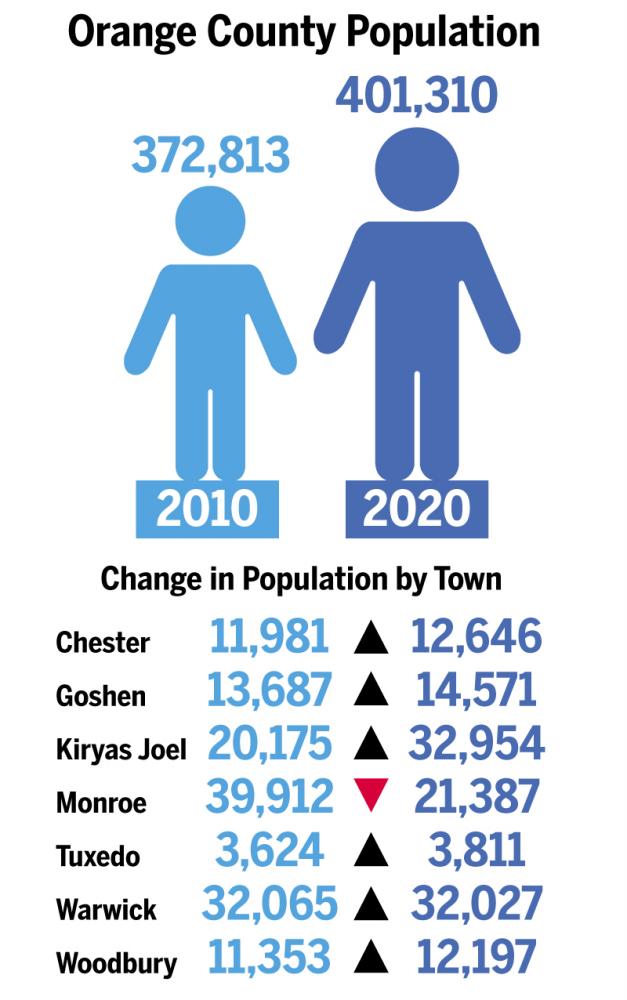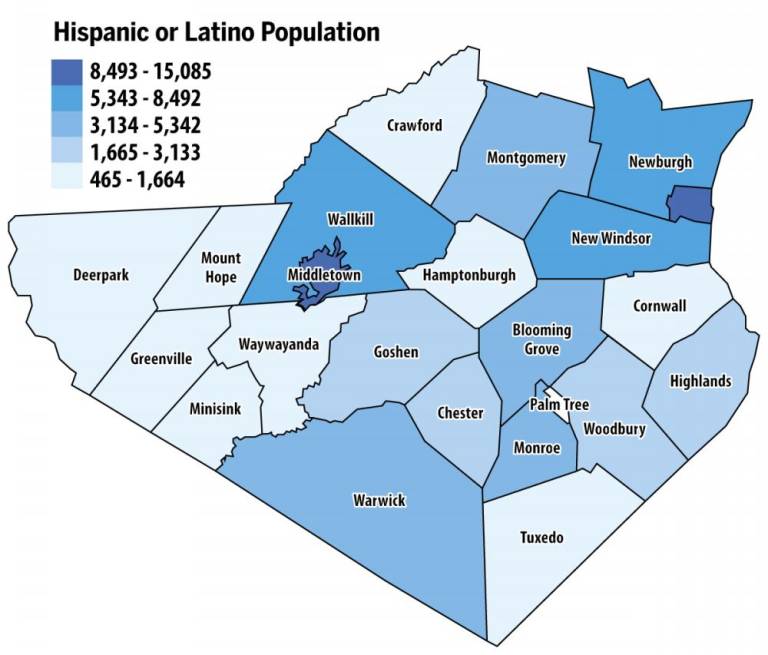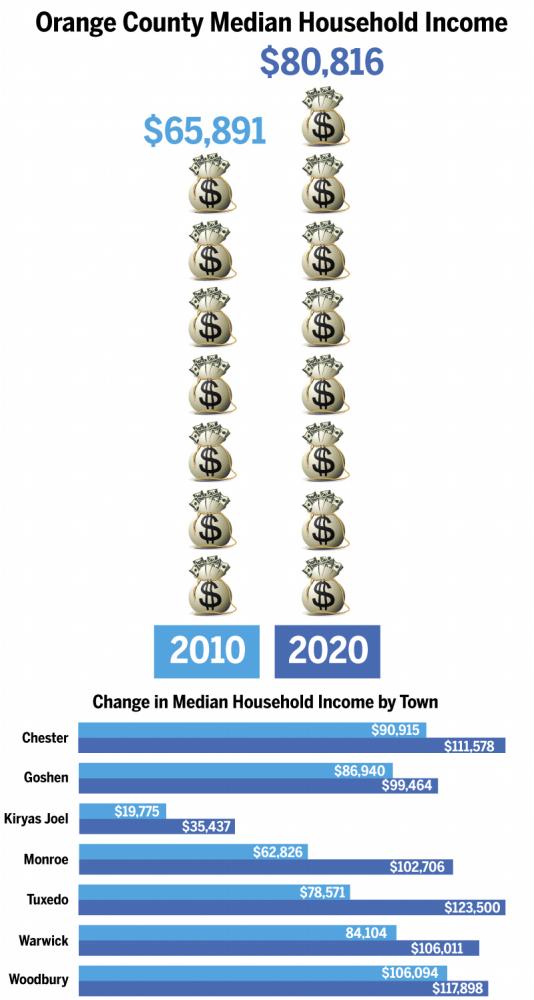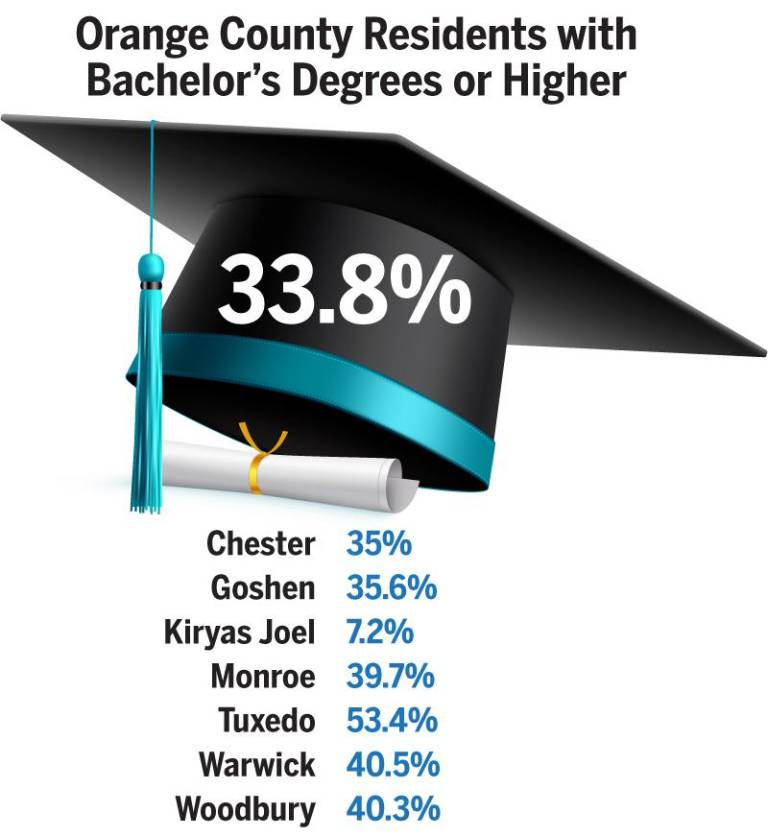Orange County’s population is the third-fastest expanding in New York State
Orange County. How did our towns change in the last decade? Straus News looked at census data for seven neighboring Orange County, N.Y. towns: Monroe, Woodbury, Tuxedo, Goshen, Chester, Warwick and Palm Tree. Here’s what we found.
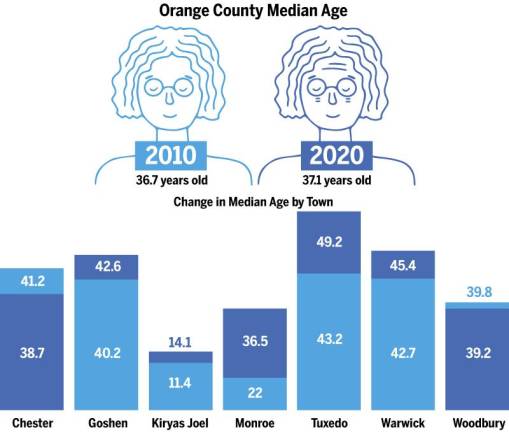
Orange County has the third-fastest growing population in the state, increasing at a rate of 7.64% between 2010 and 2020, trailing only behind Kings County (9.24%) and Queens County (7.83%).
While the natural birthrate is a factor, the population increase is influenced more heavily by people moving into the county, said Orange County Planning Commissioner Alan J. Sorensen.
Why are people flocking to our towns?
“Employment opportunities, quality of life, proximity to the metropolitan New York area, all of those things make Orange County a very attractive place to live,” said Sorensen. “And also, relatively speaking, lower housing costs than the metropolitan New York area.”
The future of Orange County
The demand on infrastructure, such as roads and highways, will continue to increase as the population grows, said Sorensen.
“But I think that the growth, overall, provides opportunities for the county,” he said. “The population growth will certainly support the business community with an increase in demand for services. And of course, the growth in the business community will also provide additional employment opportunities in the county.”
All of the towns examined for this story, with the exception of Monroe and Warwick, experienced a population increase of at least 5% over the last decade.
A significant portion of the county’s growth can also be attributed to Kiryas Joel, now the Town of Palm Tree, where 21.3% of the population is under the age of 5, compared to the county average of 6.7%. The census estimates that Kiryas Joel’s population grew 63%, from 20,175 in 2010, to 32,954 in 2020; an increase of 12,779.
Over the decade, the county’s overall population went from 372,813 to 401,310; an increase of 28,497.
Movement in Monroe
2010 census data shows the village Kiryas Joel as part of the Town of Monroe – before voters decided to split Kiryas Joel from Monroe to create the Town of Palm Tree in 2017.
Because Kiryas Joel’s population is now part of the Town of Palm Tree, Monroe’s 2020 census numbers show significant change over the decade; the population decreased 46%, from 39,912 in 2010 to 21,387 in 2020.
The median age for Monroe residents, prior to the creation of the Town of Palm Tree, was just 22 years of age. In 2020, that number is now 36.5.
Warwick changes, yet remains the same
The Town of Warwick is an outlier, with a 0% population change. The 2020 census estimates the town grew by just 38 people over the decade.
“I would say it’s our fairly successful farmland preservation program, which preserved almost 5,000 acres of working farms,” said Warwick Town Supervisor Michael Sweeton. “So we’re not building huge subdivisions like other places in the county.”
And while Warwick’s population has not changed, its demographics have.
The Black population in Warwick declined 18% from 1,631 in 2010 to 1,377 in 2020. Every other town examined for this story saw an increase in Black and African American populations.
Orange County’s Black and African American population is 11%, up 17% over the decade. In Warwick, the Black population is now just 4%, compared to neighboring towns such as Monroe and Chester which are 8% and 9%, respectively.
Hispanic and Latino population grows
Warwick’s Hispanic and Latino population, on the other hand, grew 35% over the decade, which is on par with the county’s growth of 34%. The Hispanic and Latino population in Warwick makes up 14% of the town’s total population, which is below the county average of 22%, and neighboring towns such as Chester at 19%, Monroe at 25%, and Goshen and Woodbury, both at 22%.
“We’ve always had a strong Hispanic migrant population. Our farm industry, I think that helps preserve that population. But I think it also allows transition from the farming community into other industries, other jobs, other vocations” added Sweeton. “They’re finding that this is their home...they also want to be here, and maybe branch out to other things. There are families that have been here for generations; seeing their children maybe leaving the farms or the idea of being a farm laborer and pursuing other avenues...which is sort of the American story, right?”
A portion of the county’s Hispanic and Latino population growth can be attributed to first-generation immigrants as well, which prompted local school districts to add courses such as English as a Second Language, explained Commissioner Sorensen. This growth also prompted the county to enhance its public transportation services.
“Some of the newer immigrants to the county, traditionally, have been a little more dependent on public transportation, so we’re looking at the opportunities to enhance our bus transit system throughout the county,” said Sorensen. “And just making sure that, where the need arises, we have some translation services available.”
Deeper Pockets
With the exception of Palm Tree, all towns examined for this piece exceed the county’s median household income of $81,816. Over the decade, Orange County’s median household income increased by 23%.
Incomes in Goshen and Woodbury, however, only grew 14% and 11%, respectively.
Incomes in the town of Monroe, meanwhile, soared 63%, likely due to the loss of Kiryas Joel between 2010 and 2020.
The town of Tuxedo also saw an increase, jumping from $78,571 in 2010, to $123,500 in 2020, a 57% increase.
Increased Degrees
With the exception of Palm Tree, all towns examined are home to more college graduates than the county average. 33.8% of Orange County’s adult residents have a bachelor’s degree or higher. Approximately 40% of residents in Warwick, Woodbury, and Monroe, meanwhile, have a four-year-degree. In Tuxedo, that number is a whopping 53%.
